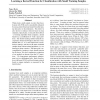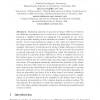24 search results - page 3 / 5 » Naturalness classification of images into DCT domain |
77
Voted
JMLR
2010
14 years 6 months ago
2010
Classification problems with a very large or unbounded set of output categories are common in many areas such as natural language and image processing. In order to improve accurac...
ICML
2006
IEEE
16 years 14 days ago
2006
IEEE
When given a small sample, we show that classification with SVM can be considerably enhanced by using a kernel function learned from the training data prior to discrimination. Thi...
102
click to vote
IPMI
2001
Springer
16 years 15 days ago
2001
Springer
Statistical analysis of anatomical shape differences between two different populations can be reduced to a classification problem, i.e., learning a classifier function for assignin...
109
click to vote
ICML
2009
IEEE
16 years 14 days ago
2009
IEEE
Sparse coding--that is, modelling data vectors as sparse linear combinations of basis elements--is widely used in machine learning, neuroscience, signal processing, and statistics...
102
click to vote
TMM
2002
14 years 11 months ago
2002
Modeling spatial context (e.g., autocorrelation) is a key challenge in classification problems that arise in geospatial domains. Markov random fields (MRF) is a popular model for i...


